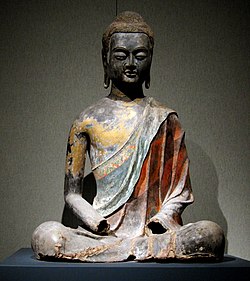 Location
LocationAs one would expect with the history of the sectarian period, the different sects each have their own accounts. The account by the Theravada sect, found in the Dipavamsa, seems to be merely a mythic account designed to glorify the Theravada sect itself, written at a time when the historical situation had been forgotten.
According to one account, the Mahāsāṃghika sect was formed in the first Buddhist schism around 320 BCE. It split from the Sthaviravāda (Elders) school over disputes about the authenticity of certain texts which the Mahāsāṃghikas claimed had been invented by the Elders and were not genuine Word of the Buddha (Buddhavacana). In this account, they did not join the third buddhist council.
There are several other accounts: from the Sammitiya sect, the Sarvastivadin sect and others.
The Mahāsāṃghikas' own account of their origins states that they divided from the Sthaviravadins on friendly terms at a meeting convened by the King following King Pushyamitra who persecuted Buddhism, probably meaning Agnimitra[1]; therefore after the Third Council. It is not clear from this account that this division would have counted as a formal 'schism' in the technical sense. The issue was, according to them, that the Elders had composed a new redaction of the Vinaya. According to them, the King (and implicitly the writers too) acknowledged both redactions as valid, but it was considered that the monks must choose to follow one or the other; they could not vacilate between both. So those who followed the old Vinaya edition were called the Mahāsāṃghikas, and those who followed the new edition were called the Sthaviras. The Mahāsāṃghikas' account gives each of the major sects listed, with the colour of the robe that they wear.
Vinaya Recension
"Arya-Mahasamghika-Lokuttaravadin Bhiksuni-Vinaya"; edited by Gustav Roth, 1970.
Abhisamacarikadharma of the Mahasamghika-Lokottaravadins (input by Abhisamacarika-Dharma Study Group, Taisho University); GRETIL Archive http://www.sub.uni-goettingen.de/ebene_1/fiindolo/gretil/1_sanskr/4_rellit/buddh/abhisdhu.htm
Mahasamghika and Mahasamghika-Lokuttaravadin Vinayas in Chinese translation; CBETA Taisho digital edition.
"The Earliest Vinaya and the Beginnings of Buddhist Literature"; Frauwallner, Serie Orientale Roma, 8. Rome: Istituto Italiano per il Medio ed Estremo Oriente.
"Vinaya-Matrka - Mother of the Monastic Codes, or Just Another Set of Lists? A Response to Frauwallner's Handling of the Mahasamghika Vinaya"; Shayne Clarke. Indo-Iranian Journal 47: 77-120, 2004.
"Sects and Sectarianism"; Bhikkhu Sujato, forthcoming.
"Researches on Bhikkhuni Sanghadisesa Three"; Bhikkhu Santi, forthcoming.
"Schism, Harmony and Communion"; Bhikkhu Santi, forthcoming.
"A Survey of Vinaya Literature"; Charles Prebish. Originally, Volume I of The Dharma Lamp Series. Taipei, Taiwan: Jin Luen Publishing House, 1994, 157 pages. Now published by Curzon Press.
"The Fundamental Teachings of Early Buddhism"; Choong Mun-Keat. (Contains an account of Master Yin-Shun's theory that the Samyukt'Agama is the oldest collection, by a student of Prof. Rod Bucknell.)
"History of Mindfulness"; Bhikkhu Sujato, 2006. (Gives further evidence for the Anga-theory of Master Yin-Shun and the theory that the Samyukta-/ Samyutta- is the oldest organising principle.)
In the future, this article should also refer to:
"Buddhist Monastic Discipline: The Sanskrit Pratimoksa Sutras of the Mahasamghikas and Mulasarvastivadins"; Charles Prebish. Volume I of the Institute for Advanced Studies of World Religions Series. University Park: The Pennsylvania State University Press, 1975, 156 pages. First Indian Edition, Delhi: Motilal Banarsidass, 1996. (This is only a translation of a small part of the Vinayas, on its own it is nearly useless.)
"Mahasamghika Origins: The Beginnings of Buddhist Sectarianism"; Charles Prebish and Janice J. Nattier. History of Religions , 16, 3 (February, 1977), 237-272.
"The Pratimoksa Puzzle: Fact Versus Fantasy"; Charles Prebish. Journal of the American Oriental Society , 94, 2 (April-June, 1974), 168-176.
"A Review of Scholarship on the Buddhist Councils"; Charles Prebish. Journal of Asian Studies, XXXIII, 2 (February, 1974), 239-254.
"Theories Concerning the Skandhaka: An Appraisal"; Charles Prebish Journal of Asian Studies, XXXII, 4 (August, 1973), 669-678.
"Saiksa-dharmas Revisited: Further Considerations of Mahasamghika Origins"; Charles Prebish. History of Religions , 35, 3 (February, 1996), 258-270.
No comments:
Post a Comment